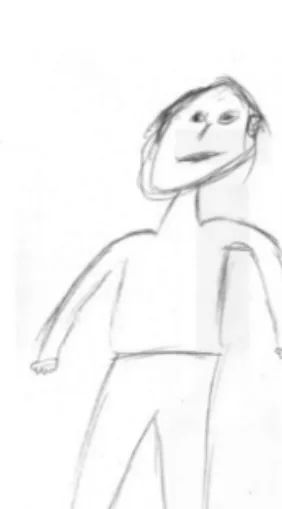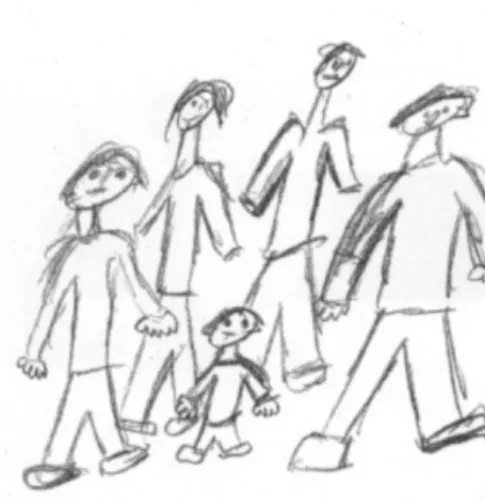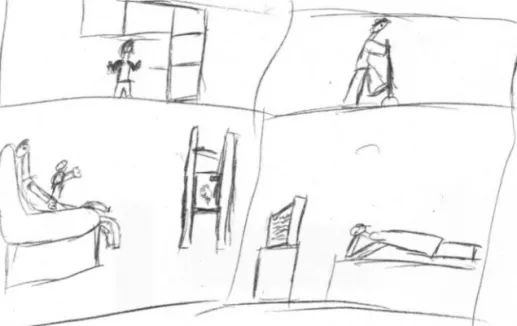Faculty of Special Education, Budapest, Hungary
Case Study of a 13-year-old Boy Suffering from
Depression and Stuttering
Abstract: Studium przypadku trzynastolatka cierpiącego na depresję i jąkającego się. Przyczyną za burzeń emocjonalnych, niepłynności mowy i depresji chłopca są jego przeżycia z wczesnego dzie ciństwa – chłopiec w wieku trzech lat został oddzielony od matki.
Słowa kluczowe: jąkanie, psychologia kliniczna, depresja, separacja, samobójstwo
Introduction
In clinical practice there is a frequently occurring problem, namely, who has the competence to treat stuttering. Speech therapists often think that – because of the emotional background of stuttering – it is better to refer children who stut ter to psychotherapy. In spite of this, psychologists regard stuttering as a speech problem and send back children who stutter to the speech therapist. As we know speech therapy can develop the fluency of speech, communication ability, self expression, selfcompetence, and finally can reduce or eliminate the symptoms of stuttering. Although children who stutter may have serious emotional problems, and speech therapists – after a complex examination – have to decide who is com petent in the treatment.
This paper presents the diagnostic process of a 13yearold boy who stutters and suffers from depression in order to outline the competence of a speech therapist in the treatment of people who stutter.
Childhood depression
Depression affects people of all ages, including children and young people. Depression among schoolaged children is becoming increasingly commonplace. Children and adolescents with major depressive disorder are much more likely to commit suicide. Depression in schoolaged children is real and it is a serious prob lem that all too often goes unnoticed. The most common symptoms of depression are feeling worthless, anxious, empty, irritated, hopeless, loss of interest in activities, hobbies, or relationships, reduced pleasure in daily activities, inability to enjoy activ ities which used to be the sources of pleasure, change in appetite, persistent difficulty in falling asleep or staying asleep, difficulty in concentrating or making decisions.
Sigmund Freud suggests that depression also involves guilt and selfcriticism, which can be related to loss during childhood. Anger or hostility may be directed at parents if they do not give the child the love and warmth that is needed for healthy development. However, these destructive feelings are turned inwards and the child blames itself for the loss, which leads to guilt and selfcriticism1.
Rene Spitz observed that infants separated from their caregivers for a long period exhibit developmental delays, depression and withdrawn affects, and unresponsive ness toward hospital caregivers2. According to John Bowlby the human infant has
a need for a secure relationship with adult caregivers, without which normal social and emotional development will not occur. Parental behaviour lead to the develop ment of patterns which will guide the individual in later relationships3.
The role of separation in the etiology of stuttering
Sara Klaniczay observed the mothers’ report of children who stutter and found that among 80 children who stutter 39 were separated from their mother before the onset of stuttering. In a high percentage of cases a lengthy separation from mother preceded the development of the disorder. The child either having gone on holiday or into hospital without his mother, or mother having left home. In her view frus tration of the child’s need to cling is fundamental to the formation of stuttering4.
1 S. Freud: Mourning and Melancholia. “The Standard Edition of the Complete Psychological
Works of Sigmund Freud” 1957, Vol. 14, s. 1914–1916.
2 R. Spitz: Hospitalism: An inquiry into the genesis of psychiatric conditions in early childhood.
“Psychoanalytic Study of the Child” 1945, Vol. 1, 53–74.
3 J. Bowlby: Attachment and Loss. New York, Basic Books 2 1969.
4 S. Klaniczay: On Childhood Stuttering and the Theory of Clinging. “Journal of Child Psy
Gertrude Wyatt says that the speech development can be successful only if the relationship between mother and child is uninterrupted. Absence of such relation ship may produce a crisis of speech development.
The kind of the anxiety she observed in young stuttering children may best be described as a fear of losing immediate access to and close contact with the mother or as an intensive longing to be closer to her5.
Peter Glauber wrote extensively about stuttering as a defensive reaction to the trauma of the child’s feelings of separation from mother. In his experience, the pre dominant cause of stuttering is separation anxiety, but especially in the context of the fantasy of the motherchild symbiosis6.
Margaret Wilkinson argues that early symbiotic fusion needs in conflict with the need to separate produce stuttering. She suggests that one of her patient’s stutter was symptomatic of him getting ‘stuck’ in the processes of separation because of his need to remain fused with mother7.
Winslow Hunt describes the central conflict within the stutterer’s personality to be “between the wish to be in harmony with the mother and the wish to become his own independent self”8.
As we know, that early experiences in childhood have an important influence on development and behavior in later life. I think that children, who endured early separation, are more sensitive to the later separation, and become independent more difficultly.
Case study
A 13yearold boy was referred to speech therapy because of his stuttering. He started to stutter when he was three years old and that time he also had bedwetting problem.
In the early period during his diagnostic process it turned out that he had serious emotional problems. He was often moody and sad without any reason. Sometimes he became irritable and withdrew from social situations. At that time he lost his interest in school and was thinking about committing suicide. I used
5 G.L. Wyatt: Language Learning and Communication Disorders in Children. New York, The
Free Press 1969.
6 I.P. Glauber: The psychoanalysis of Stuttering. Stuttering. In: Symposium. Ed. J. Eisenson.
New York, Harper and Brothers 1958.
7 M. Wilkinson: His mother-tongue: from stuttering to separation, a case history. “Journal of
Analytical Psychology” 2001, Vol. 46, s. 257–273.
8 W.R. Hunt: The psychology of stuttering; the insights of I.P. Glauber. “Contemporary Psy
different methods during his examination: “first interview”, “mother report”, “draw ings”, “Rorschach test”9 and explore his intention of suicide.
First interview
What we call it first interview is when we first see the patient to obtain the basic information about his problem.
The grandparents called me because of their grandson’s stuttering. The mother and her son come to our first appointment. The boy is tall and thin. Moody, not happy. He seems older than his age. He speaks very low. The mother, appeared to be about 30 years old. She was an average woman, long, brown hair, big brown eyes, smiling face. She says that the teacher complains about her son, who has behavio ral problems in school. He is not able to control his strong emotions. He is often angry, because his classmates tease him. She adds that, he is often moody and sad. She feels that he has affinity to depression. She tells an incident when strange boys attacked her son while he was walking in the street on his way to the video shop. They teased him, got around him and when he tried to run away (escape), they trip ped him up, he stumbled and hurt his knees. He did not know those guys in person, just somebody by sight. This case shocked him very much, and since them he has become more introverted and started to think about committing suicide. He told it first to his teacher in the school, who called his parents, but they did not attach great importance to this and did not ask for help.
Aaron thinks that the source of his problems, that when his classmates make him angry, he can not control his emotions. The teacher notices, when he starts to hit them, and she punishes him. I did not perceive his stuttering as being very strong during our conversation, just only a few blocks interrupted his speech.
Mother report
The next time I met the mother to obtain data about her child development. From the history the following details are important. The mother was compa ratively young when she became pregnant, she was 21 years old. The pregnancy and birth were normal. Aaron was breastfed for 6 months, was walking at 9 months and was toilet trained by 3 years. It was interesting, that the mother did not remember his speech development. He did not fit in the nursery school, but later he managed adapt to it. He was lonely in the school and did not have any friends. He began to stutter at 3 years old and he had bedwetting problems, when he was 4 years old.
9 H. Rorschach: Psychodiagnostics: A Diagnostic Test Based on Perception. Cambridge, MA
He has got 2 brothers Mike and Adam. Mike is 12 and Adam is 7 years old. When his brother was born he was only 1 year old, and the birth of Mike was a shock for him. When Mike was born, his mother went unexpectedly to a hospital. His father was very busy with his work and left the child in the care of grandparents in their house so the grandparents took care of him. Grandmother did not allow him to be taken to the hospital because it would disturb him. He changed very much, when they took him finally and rejected his mother. It was a traumatic experience for him, because he was to young to be separeted from his mother for a long period.
Drawings
I used different drawing test in the next period of the diagnostic process.
Draw the Person – House – Tree Technique
The housetreeperson test (HTP) is a projective personality test, a type of exam in which the test taker responds to or provides ambiguous, abstract, or unstructu red stimuli (often in the form of pictures or drawings). In the HTP, the test taker is asked to draw houses, trees, and persons, and these drawings provide a measure of selfperceptions and attitudes. As with other projective tests, it has flexible and subjective administration and interpretation.
Draw the Person. He draws the figure of the person with a suitable size. The
figure is not too small and not too big according to the size of the paper. He placed it in the center of the page. The lines are entangled. He draws the shape of the figure, especially the head with more than one line. It is not looking for eye contact. It seems that the figure makes a vague step with his left foot.
Draw the House. The drawing of the house is schematic. The lines are also
entangled. The house is not symmetrical.
Figure 2. Aaron’s house
Draw a Tree. The shape of the tree is also schematic. The proportion of the
branches and the trunk is suitable, but the branches seems more dominant than the trunk. The roots, which symbolize the past, are not visible, but this is customary in children, because they are concerned about the present. The lines of the branches, which symbolize the relation to people, are entangled.
Figure 3. Aaron’s tree
Family Drawing
The drawing of the family always gives interesting information about the rela tionships in the family. They represent unconscious desires and fantasies of the per son who draws them. In the picture (from left to right): Mike, his mother, Adam, father and him. He draws himself on the picture at the last one, but his shape is the largest one. His two brothers stand next to their mother and he stands next to his father.
Figure 4. Aaron’s family
Fantasy Family
This is his “fantasy family” drawing. The task is: to transform his family into any thing he wishes. In his “fantasy family” his father is a house. The house is a home. The house symbolizes a feeling of safety. His mother has become a heart. The heart is the symbol of the affection. Mike is an pinball machine, because he is a winner. It symbolizes his feeling that his parents prefer Mike over him. Adam is a mouse, because he is the youngest one, and less brave than his brothers. Aaron has become a TV box, because he likes watching TV.
Figure 5. Aaron’s fantasy family
Kinetic Family
I have found that asking children to draw their family during action is very informative. This type of the family drawings manifests the togetherness of the family. For example, if the family members act together it can express their solida rity feelings for each other. In his “kinetic family”: his mother washes up the dishes (left upper). Father digs a garden. His two brothers watch TV. He separately wat ches TV in his own room.
Figure 6. Aaron’s kinetic family
Mother – Child
The task is: to draw a mother with her child. This drawing points out the charac teristic of the relationship between mother and her child. In the picture they reach for each other but they are not attained each other.
Rorschach test10
Next session we made the Rorschach test. The Rorschach test was developed by
the Swiss psychiatrist Hermann Rorschach. The test consists of 10 cards, which are actually symmetrical ink blots. Some are black and white and some are colored. In theory the respondent will project his motives into the descriptions he provides of the inkblot. The responses are scored on three major features:
■ We call the first one: The location. In this viewpoint we observe whether the response involves the entire inkblot or some part of it. The location of the respons es shows, how the individual can adapt to the world. For example, if the person refers to the whole stimulus it means, that person is able to look at the world from a perspective but keeps a distance from the reality. If the person refers to the part of the inkblot it may mean that he is closer to the real life, but gets lost in the details.
■ The second one is: Determinants. In this viewpoint we observe whether the subject responds to the shape of the blot, it’s color, or differences in texture and shading. The determinants show the sociability and the anxiety of the person. For example the introversive persons ascribe more moves to the inkblot than extro verted ones. The anxious persons’ answers the shading of the blots are determi nate, not though their contour.
■ The content of the response. In this viewpoint we observe what the response represents. This is the symbolic meaning of the responses. Rorschach validat ed method of diagnosing anxiety and hostility from the content of a subject’s responses to the ink blots. For example hostility and anxiety is revealed by such responses as “gun” and “blood” and other explicit expressions or cultural sym bolisms of this emotions. The blots are differentiated from each other. Each blot can signal specific meaning. For example there are “mother” and “father” blots. We observe how the subject responses refers to the hidden meaning of the blot. Aaron’s Rorschach test results from the various analyzing viewpoints:
■ According to the location of his responses he can adapt to the world and he is close to the real life.
■ The determinants show, that he is more introverted and he is full of a fear and anxiety.
■ Anxiety and hostility appeared in the content of his responses to the ink blots. Hostility is revealed by such responses as “dagger”. Anxiety is revealed by such responses as “blood”. In his responses to the “mother blot” appeared his ambiva lent relationship to his mother. According to my explanation: he seems not to be able to separate from his mother and this is the reason of his anxiety, which he tries to eliminate it with his aggression. In his response of the VIIIth blot describes his problem to separate from their parents. He says: “Two pumas, one
on the right, one on and the left side of the page, compress the butterfly with their hind legs, prevented him going away”.
Figure 8. The VIIIth blot of the Rorschach Test
Exploration of suicidal thoughts
I devoted one session to the exploration of his suicidal thoughts. I wanted to know how realistic his intention to commit suicide was. The dialogue between us was the following.
Since when have you had thoughts like this? Where would you commit sui-cide? My suicidal thoughts started on the middle of January the first. It was because
of my troubles in school. I was seriously of jumping out of the window in school because the others pestered me all the time.
What would your classlmates have believed if you had done it? They would
have thought that I was stupid. But they would have reflected on what had been done to me especially, Thomas and George. Supposedly the others didn’t notice, what was done to me.
What would your teacher have believed if you had done it? She would have
been very sad, but she would not have been surprised, because she knew that I was sad because the others teased me.
What would your mother have believe? She would have thought that I had
committed suicide because I was sad. She would act so like when grandma died. She went out into the garden. Sat down and cried. Maybe, my death would have shocked her better. Grandma was ill and counted on her death. My death would have been unexpected. She would have put herself through it in 2 or 3 months. She would have thought that she did not care about me. She did not pay attention to me. I withdraw into myself. I turned a deaf ear to her. I pushed myself away from her.
What would your father have believed? He probably would get through it more
easily, but it could be, that he would become more introverted and would start to think of committing suicide himself. My mother told me, that when my father’s first wife left him, it had a big effect on him. He become more introverted and he probably thought of committing suicide, but he never mentioned it.
What would your grandparents have believed? Granddad considers suicide
a taboo. He never expresses his emotions, but he would have mourned for mon ths. He raised my father strictly. My grandmother would have been very sad but she would take care of my family. She would say that the family should make a step beyond this.
What would your brothers have believed? My older younger brother would
not understand it, but later he would miss me increasingly. First he would see the benefits, that he gets my room. My youngest younger brother would feel for me like for the fish that died in the aquarium.
Who would go to your funeral? Dad would surely go to my funeral and I am
not sure that my mom and my siblings would do so.
Was there anybody who committed suicide in your family? My great grand
father died when he was young. He drank a lot. He went regularly to horse races. Maybe he had suicidal thoughts.
Conclusion of the diagnostic process
Aaron was separated from his mother when his younger brother was born. The next separation from his mother was very difficult for him. He did not fit in the nursery school. He was 3 years old, when he began to stutter and 4 when he had bedwetting problems. These symptoms are signals of his anxiety. I thought that his stuttering could be seen as a reaction to his early separation.
Fitting in into the community always goes slowly for him. He also has integra tion difficulties in school. He was lonely and his classmates tease and exclude him, which makes him angry. Not long ago his mother changed workplace and spends less time at home. Not much later he started being concerned about his depressed symptoms and suicidal thoughts.
During the diagnostic process I realized that his problems are deeper than speech therapy could help with. After the analysis of the result I decided to refer him to psychotherapy before he would start speech therapy.




